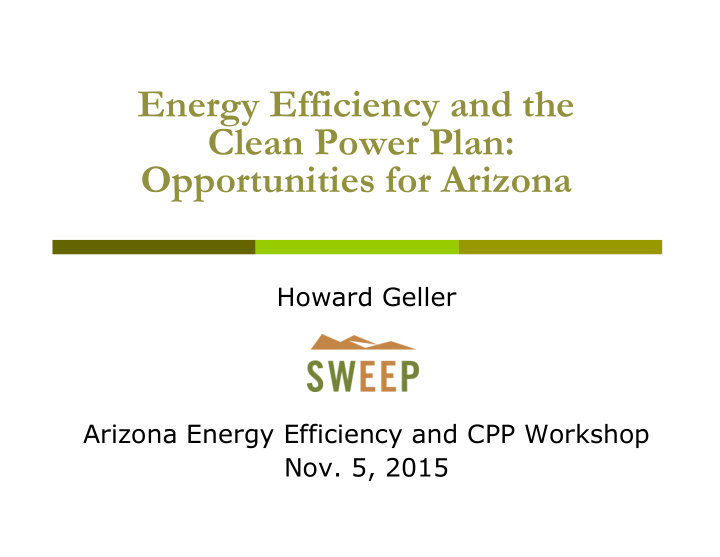



Energy Efficiency and the Clean Power Plan: Opportunities for Arizona Howard Geller Arizona Energy Efficiency and CPP Workshop Nov. 5, 2015
The Southwest Energy Efficiency Project (SWEEP) � Non-profit organization with a 14 year track record � Works on utility, building efficiency, transportation and industrial policy and and programs � Works closely with state and local governments, energy efficiency businesses, utility companies, and other clean energy advocates � Funding provided mainly by charitable foundations, U.S. DOE, and business allies
Energy Efficiency Includes a Broad Set of Options and Measures
Which EE Measures and Programs Can be Included in State Plans? � Wide array of utility and non-utility policies, programs and measures are allowed: � Utility DSM/EE programs � T&D energy efficiency and loss reduction efforts � State or local building energy codes or retrofit ordinances � State tax incentives or financing programs � ESCO projects and public sector efficiency programs � Industrial efficiency projects or programs � CHP and waste-to power projects � State appliance/equipment efficiency standards � Low-income home weatherization � Behavior change programs
Utility Program Considerations � EE measures/programs implemented starting in 2013 can provide ERCs if they are saving energy in 2022 and beyond � ERCs possible for both technology and behavior- based programs—all savings count equally � ERCs possible for T&D system loss reduction, utility-supported CHP and waste-to-power projects � State plans must specify how double counting of energy savings/ERCs will be avoided—who gets the credits? � None of this applies if a state takes a mass-based approach, other than for CEIP credits or if there is an allowance set aside for EE measures/programs
Non-Utility Program Considerations � Other types of EE measures and programs can provide ERCs or help with mass-based compliance � Up-to-date local building energy codes � Low-income home weatherization � ESCO projects in the public or private sector � State/local financing programs or tax credits � EE projects that do not participate in utility programs; e.g., in rural areas � Who gets the credits when utility support is also provided? - state needs to decide this � State needs to ensure proper EM&V is done, verify savings claims, issue and track ERCs…if AZ goes with rate-based compliance
What Does SWEEP Recommend in States That Go Mass-Based? � Commit to strong utility and non-utility EE policies and programs in order to reduce load growth and help utilities comply with mass-based targets � Take a least-cost approach to CPP compliance planning, and in doing so consider full costs and benefits of EE initiatives � Consider EE policies and programs as complementary to specific actions in the state’s CPP plan � Include interstate and intrastate trading of emissions allowances in the state plan � Auction off some or all emissions allowances and dedicate a portion of the proceeds to new/expanded EE programs � EE initiatives in rural areas � EE programs in low-income communities � Energy code and other market transformation initiatives � Consider issuing some emissions allowances to EE measures/ programs, possibly in “hard to reach markets”
What Does SWEEP Recommend in States That Go Rate-Based? � Commit to strong utility and non-utility EE policies and programs in order to generate low-cost ERCs and help utilities comply with rate-based targets � “Work Your ERCs” – take full advantage of potential ERCs so that EE efforts help rather than hinder a state with compliance � Without ERCs, energy savings can increase a utility or state’s average emissions rate even though CO 2 emissions are cut � Take steps to identify and issue legitimate ERCs for EE programs and measures implemented starting in 2013 � Develop or modify EM&V procedures so that they comply with EPA requirements for both utility and non-utility programs � Establish ERC verification, issuance and tracking systems, and ensure proper EM&V is being done � Establish and implement rules regarding who is eligible for ERCs, and ensure there is no double counting of savings or multiple ERCs for the same MWh of savings
General Recommendations � Continue strong EE efforts prior to and after 2022—doing so will help reduce CO 2 emissions and/or increase available ERCs � Take advantage of the CEIP and get as many bonus ERCs or emissions allowances as possible � Maximize cost-effective EE efforts even if AZ doesn’t need energy savings to comply with CPP requirements, thereby enabling sale of excess emissions allowances or ERCs to states that need them � Consider which compliance approach will facilitate interstate trading as part of state decision regarding rate vs. mass � Monetize avoided CO 2 emissions in EE policy and program cost effectiveness analysis � Strongly consider going mass-based: it will be much easier from perspective of implementing and getting appropriate credit for a wide range of EE measures and programs
What’s At Stake in Arizona? � Potential to achieve 20-25% electricity savings by 2030 from EE policies and programs implemented 2016-2030 � Saving ~18 TWh/yr in 2030 – equivalent to the electricity supply of nine 300 MW baseload power plants � Big contribution to CPP compliance � Around $7 billion in net economic benefits for consumers and businesses � Reduction of other pollutant emissions and improved public health Note: Stay tuned for in-depth SWEEP analysis of these issues
SWEEP: Dedicated to More Efficient Energy Use in the Southwest Resources available online at: www.swenergy.org Howard Geller, Executive Director 303.447.0078 x1 hgeller@swenergy.org
Recommend
More recommend